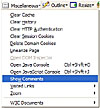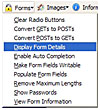- The Accidental Tester
- WebGoat and Firefox Web Developer
- WebScarab and Ethereal
- Next Steps
WebGoat and Firefox Web Developer
The first trick to learning security testing is selecting an application to help you find security bugs—without getting arrested. One such application, WebGoat, is a full J2EE web app developed and maintained by the Open Web Application Security Project (OWASP). OWASP designed WebGoat to teach web-application security lessons. WebGoat provides a safe and legal environment in which you can practice your testing. It's divided into lessons that teach users how to exploit a real vulnerability on the local system. The value of WebGoat is that it provides not only a safe environment, but hints to help you with your testing. It offers four levels of hints and has features that show the user cookies, parameters, and the underlying HTML and Java code if desired.
The second tool we'll consider is the Web Developer extension for Mozilla Firefox. For a number of reasons, Web Developer is a must-have for any web application tester, but in this article we'll just look at some of the features that help test security. I regularly use these features, for example:
- Disable cookies
- Convert GET to POST and vice versa
- Make form fields writable
- Display form details
- View cookie information
- View response headers
- Clear cache/authentication/cookies
- Show comments
We'll also examine two other open source tools a little later, but for right now let's focus on some WebGoat and Web Developer examples. To use WebGoat, you might need to install Tomcat and the latest Java Development Kit (JDK). It can take some time to get WebGoat set up, but I encourage you to do it now if you want to follow along. The following examples use WebGoat and Web Developer together.
HTML Clues
Let's start with the HTML Clues example in WebGoat. As illustrated by my security testing experience described earlier, developers can sometimes leave meaningful information in the source code when they don't think anyone will be looking at it, or when a company coding standard forces them to leave comments in the source code when updating. By reviewing the source code for comments such as usernames, passwords, backdoors, or even commented-out links, we can learn a lot about what the developer was thinking when writing the code (or maintaining it).
Figure 1 shows the sign-in form from the WebGoat HTML Clues example.

Figure 1 Sign-in form from the WebGoat HTML Clues example.
Let's say you wanted to look at the source code to read the comments. You could right-click and select View Source, but then you have to know what a comment looks like. What if you don't know how to read HTML? Or what if the HTML is so complex that it's really hard to find and read all the comments? In the Web Developer toolbar is a Miscellaneous menu. If you select it, you can then select Show Comments (see Figure 2).

Figure 2 Showing comments in Web Developer.
This command will insert an exclamation point (!) icon on the screen wherever a comment appears in the code. If you click the exclamation point icon, you'll see the comment that the developer left in the code (see Figure 3).

Figure 3 Comments in the WebGoat HTML Clues example.
Just as in my experience described earlier, the developer has left a password in a comment. The purpose of this exercise is to get you to recognize the fact that information like this is sometimes included in the source code. WebGoat is also kind enough to give you the password, because the point of the exercise is simply to get you looking at the code for comments. If you enter the username and password, you get your reward, as shown in Figure 4.

Figure 4 Successful completion of the HTML Clues example.
Ah, the sweet smell of success. It's scary to know that sometimes it really is just that easy.
Hidden Field Tampering
Developers sometimes use hidden fields to maintain information about your session that they need to remember, but don't want you to see. For example, sometimes a loaded page will include hidden credentials, pricing information, or details about items ordered. This can be an easy way for developers to track information, but it's similarly easy for a hacker to edit the info. A couple of years ago at a conference, Herbert Thompson (coauthor of How to Break Software Security) related an experience in which he did something similar to this little trick, to the tune of a couple thousand dollars on a popular web site. It was only through his kind nature that the owners of the site were made aware of the mistake and were able to fix the problem. It was a compelling story.
The form in Figure 5 is from the Hidden Field Tampering example in WebGoat.

Figure 5 Shopping cart from the Hidden Field Tampering example in WebGoat.
Now let's take a look behind the scenes. Again, you could view the source code to see what's hiding in there, but that assumes you can read the code. Worse, it doesn't allow you to change the values even if you do find a hidden field. Traditionally, you would have to use a program to intercept and change the hidden field value that you found in the source code. Web Developer has made all this easy. On the menu, select Forms, Display Form Details (see Figure 6).

Figure 6 Displaying form details in Web Developer.
This option will show you all sorts of details about the page currently displayed. One bit of information displayed (and editable) is the hidden fields on the page, as shown in Figure 7.

Figure 7 Shopping cart with form details displayed.
If you change the value of the Price hidden field, you'll change the value sent to the server when you click Purchase. For example, if I enter the value 2.00 and submit the page, I get the result in Figure 8.

Figure 8 Successful completion of the Hidden Field Tampering example.
For only $2.00, I might even purchase a second HDTV for my basement!
We could look at some other examples, but I think you get the idea. WebGoat is a learning tool, and Web Developer is a handy tool to have around because it simplifies many of the things that we need to do at the source code level.
Now let's switch gears and examine another type of tool.
